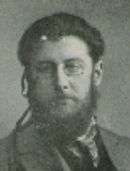Jean Huré

Jean Huré (17 September 1877 in Gien, in Loiret department – 27 January 1930 in Paris) was a French composer and organist. Though educated at a monastery in Angers, as a musician, he was mostly self-taught. His only published organ work is the 1913 Communion pour une Messe de Minuit à Noël.[1]
Life
Huré studied anthropology, composition, improvisation and medieval music at the École St-Maurille Angers and served as organist at the cathedral in the city. In 1895 he went to Paris, where he, Charles-Marie Widor and Charles Koechlin were advised to study at the conservatory. Huré preferred to live an independent life.
From 1910 he taught at the École Normale Supérieure, where Yves Nat and Manuel Rosenthal were among his students. In 1911 he helped found the Paris Mozart Society. He worked as organist at the churches of Notre-Dame-des-Blancs-Manteaux, Saint-Martin-des-Champs and Saint-Séverin between 1911–1914.[1] From 1924 he was appointed successor to Lucien Grandjany at Sacré-Cœur and from 1926 as the successor to Eugene Gigout at Saint-Augustin. Between 1824 and 1826 he edited and published a monthly journal called L'Orgue et les Organistes.[1]
In addition to a number of organ works Huré composed a comic opera and a ballet, three symphonies and chamber works. In 2010 a CD with works by Huré was recorded, featuring a four-movement sonata for violin and piano and a piano quintet performed by the Quatuor Louvigny and pianist Marie-Josephe Jude.
Works
- Stage
- Te Deum: extrait de Jeanne d'Arc, Poème théâtral (1895); words by A. Vincent
- La Cathédrale (1910)
- Au bois sacré, Ballet in 1 act (1921)
- Le Rajah de Mysore, Operetta
- Orchestral
- Symphony No. 1 (1896)
- Symphony No. 2 (1897)
- Symphony No. 3 (1903)
- Poèmes enfantins for chamber orchestra (1906)
- Prélude symphonique for orchestra
- Concertante
- Air for violin or cello and orchestra (1902)
- Nocturne for piano and orchestra (1903)
- Andante for alto saxophone, string orchestra, harp, timpani and organ (1915)
- Concertstück for saxophone and orchestra
- Concerto for cello and orchestra (1929)
- Concerto for violin and orchestra
- Chamber music
- Suite sur des Chants bretons for violin, cello and piano or harp (1898)
- Sonata in C minor for violin and piano (1900–1901)
- Petite chanson for cello (or viola) and piano (1901)
- Air in F major for cello and piano or organ (1901)
- Sonata No. 1 in F♯ minor for cello and piano (1903)
- Sonata for violin and piano (circa 1905)
- Sonata No. 2 in F major for cello and piano (1906)
- Sonatine in G major for violin and piano (1907)
- Piano Quintet (1907–1908)
- Sonata No. 3 in F♯ major for cello and piano (1909)
- String Quartet No. 1 in C major (1913–1917)
- Prélude for violin (or cello) and organ
- Sérénade en trio for violin, cello and piano (1920)
- Sonata for violin and piano (1920)
- String Quartet No. 2 (1921)
- Sonata No. 4 for cello and piano (1924)
- Organ
- Interlude-élévation for organ or harmonium (1911)
- Communion pour une Messe de Minuit à Noël (Communion on a Noel: Offertory for Midnight Mass) (1913)
- Prélude pour une messe Pontificale (1915)
- Piano
- Poèmes Enfantin (1906)
- Sonata No. 1 in F minor for piano (or harp) (1907)
- Sonata No. 2 (1916)
- Vocal
- Élégie for voice, cello and piano (1905); words by René de Brédenbec
- Te Deum for soprano, chorus and organ (1907)
- Sept chantons de Bretagne for voice and piano (1910)
- Ave Maria for 2 female voices (1924)
- L'âme en peine for 4 voices (1925)
- 4 Lettres de femmes for voice and piano (1928)
- 4 Poèmes for voice and piano (1929); words by Arnould Grémilly
- Trois chansons monodiques for solo voice (1930); words by André Spire
- Belle, j'entends bien tourner la meule du moulin for voice and chamber orchestra
- Literary
- Chansons et danses bretonnes précédées d'une étude sur la monodie populaire (Angers, 1902)
- Dogmes musicaux (Le Monde Musical, Paris, 1909)
- Technique du piano (Paris, 1909)
- Introduction à la technique du piano (Paris, 1910)
- Défense et illustration de la musique française (Angers, 1915)
- La technique de l’orgue (Paris, 1918)
- L’Esthétique de l’orgue (Senart, Paris, 1923)
- Saint Augustin musicien (Paris, 1924)
See also
References
- 1 2 3 Smith & Vierne, Rollin, Louis (1998). Louis Vierne: organist of Notre-Dame Cathedral. Pendragon Press. p. 198. ISBN 1-57647-004-0.
- Attribution
- This article is based on a translation of the corresponding article of the German Wikipedia. A list of contributors can be found there at History.